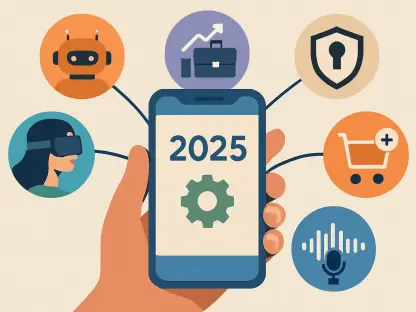The Internet of Things (IoT) is playing a pivotal role in the expansion and success of wireless cellular technologies, particularly 5G networks. As examined by industry trade organization 5G Americas and research firm Omdia, this trend highlights the ongoing growth and evolution of the IoT ecosystem and its substantial impact on the wireless telecommunications sector. The rapid growth of IoT devices and their integration with 5G networks is reshaping the telecommunications landscape, driving significant advancements and improvements in wireless connectivity.
Rapid Expansion of 5G Global Connections
The rapid expansion of 5G global connections has been remarkable, with a significant surge of 192 million connections in the second quarter of 2024. This increase brought the total number of 5G connections to 2.1 billion. This trend is expected to continue, with forecasts suggesting that 5G connections will reach an astounding 8.6 billion by 2029. The IoT ecosystem’s role in this expansion is crucial, with current global IoT subscriptions at 3.4 billion and 6.7 billion smartphone subscriptions. These figures demonstrate the rapid pace at which 5G technology is being adopted and utilized around the world.
Transition to 5G-Enabled IoT Devices
The transition from 4G LTE to 5G-enabled IoT devices is exemplified by emerging technologies like 5G RedCap (Reduced Capability). This advancement is anticipated to enhance network and energy efficiency for operators, offering them a more advanced and streamlined solution for IoT device management. IoT subscriptions are projected to reach 5.2 billion by 2029, highlighting the robust growth trajectory of the IoT market. Additionally, smartphone subscriptions are expected to surge to 8.2 billion. These projections underscore the significant role of 5G networks in facilitating the expansion and capabilities of both IoT and smartphone markets, enhancing connectivity and supporting a wide array of applications across various industries.
5G Networks Beyond Smartphones
One of the key developments in 5G technology is its extension beyond just smartphones. Viet Nguyen, Vice President of PR and Technology at 5G Americas, emphasizes the versatility of 5G networks across different applications, particularly in the realm of enterprise and business use cases. These scenarios showcase the adaptability of 5G, which is now being used in a variety of IoT-connected devices, such as sensors and cameras. These devices are being utilized in both public and private 5G networks, demonstrating the broad applicability of 5G technology and its potential to revolutionize various sectors by enabling real-time data collection and advanced analytics.
Regional Growth in 5G Connections
North America has been a significant player in the adoption and expansion of 5G technology. In the last quarter, the region recorded a total of 242 million 5G connections, constituting 34 percent of all wireless cellular connections. Additionally, North America added 23 million new 5G connections, representing an 11 percent growth quarter over quarter. By 2029, North American 5G connections are forecasted to surge to 761 million, which would account for 84 percent of all wireless cellular access technologies in the region. This remarkable growth highlights the increasing reliance on 5G networks and their critical role in supporting the region’s technological infrastructure.
Enhancements in 5G Networks
Operators are continually enhancing their 5G networks to keep pace with the growing demand and evolving technological landscape. Kristin Paulin, Omdia’s principal analyst, notes that this enhancement includes expanding coverage with mid-band spectrum and transitioning to 5G standalone. This transition enables advanced functionalities such as network slicing, which allows operators to allocate specific network resources to different types of services, and forms the basis for 5G RedCap. These advancements contribute to the overall efficiency and capability of 5G networks, making them more versatile and powerful in supporting a wide range of applications.
Growth in Latin America
Latin America has also experienced significant growth in both 4G LTE and 5G connections. The region added three million new LTE connections in the second quarter of 2024, bringing the total to 592 million. This figure represents 74 percent of all wireless cellular access technologies in the area. Additionally, Latin America added 10 million new 5G connections, reaching a total of 57 million, reflecting a 21 percent growth rate. Jose Otero, Vice President of Latin America and the Caribbean for 5G Americas, highlights that 4G LTE continues to be a reliable and affordable option, while 5G is gradually making inroads in urban areas as handsets become more available and operators expand their coverage.
Network Deployment and Global Trends
From a network deployment perspective, the global number of deployed 5G networks has surpassed the pace of 4G LTE network deployments at a similar stage in the technology cycle. As of September 16, there are 329 commercial 5G networks worldwide. This number is expected to grow with continued substantial investments in 5G infrastructure. This growth trajectory underscores the increasing importance of 5G networks to the global telecommunications landscape and their role in driving innovation and connectivity.
Regional Deployment Statistics
Breaking down the current network deployments, there are 329 global 5G networks, with 17 in North America and 47 in Latin America and the Caribbean. In comparison, there are 710 global 4G LTE networks, 18 of which are in North America and 133 in Latin America and the Caribbean. These figures underscore the rapid deployment and adoption of 5G technologies across different regions, highlighting an overarching trend towards more advanced and capable wireless networks. This trend is indicative of the ongoing global efforts to enhance network capabilities and support the growing demand for high-speed and reliable connectivity.
5G Americas and Industry Collaboration
5G Americas, based in Bellevue, WA, plays a critical role in driving the advancement of 5G and the transition to 6G throughout the Americas. The organization consists of key telecommunications service providers and manufacturers dedicated to this mission. Its Board of Governors includes notable industry players such as Airspan Networks Inc., Antel, AT&T, Ciena, Cisco, Crown Castle, Ericsson, Liberty Latin America, Mavenir, Nokia, Qualcomm Incorporated, Rogers Communications, Samsung, T-Mobile US, Inc., Telefónica, and WOM. This collaboration among leading industry stakeholders fosters innovation and supports the development and deployment of advanced wireless technologies.
Impact on Global Telecommunications
The Internet of Things (IoT) is significantly influencing the development and success of wireless cellular technologies, especially 5G networks. According to industry trade group 5G Americas and research firm Omdia, the present trend underscores the ongoing expansion and transformation of the IoT ecosystem. This evolution is having a profound effect on the wireless telecommunications industry. IoT devices are proliferating rapidly, and their integration with 5G networks is reshaping the telecommunications landscape in remarkable ways. The adoption of IoT technologies within 5G infrastructures is fostering substantial progress in wireless connectivity. This merger between IoT and 5G is enhancing device communication efficiency and enabling faster data transfer rates, higher reliability, and lower latency. As a result, industries ranging from healthcare to transportation and smart cities are experiencing unprecedented advancements. This symbiotic relationship is driving innovations that promise to revolutionize how we live, work, and interact, highlighting the central role of IoT in the future of telecommunications.









